Quality control at Electrofact.
Maintenance at
CERN.
Systems engineer
at CERN.
The Control Data
7600.
System analyst at
l'EPFL, Lausanne.
The beginning of
Personnel Computing.
|
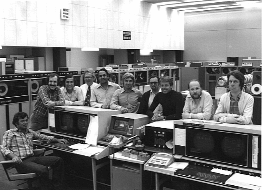
The Control Data Crew
at
CERN
|
Quality control at Electrofact.
As strange as it may sound, in the beginning I did not
want to start “working with computers” as we used
to call this in our region at that time. Anyway we know
all what followed !
It was by chance that the local unemployment office has
sent me a message that there was a job available in “Amersfoort”
in which I could possibly be interested. So I did go
there to present myself, and I finished by signing a work contract
for a job as QA controller for “Control Data”
products at one of their production sites, “Electrofact”
which they bought just a little time before that.
|
The
main part of this quality control job was to do final control and
verifying of tape drive units. On the picture shown
aside we can see the carrying out a read-head adjustment
procedure.
The
job was rather hard, then on the backside of the chassis, which
is visible on the picture, were a thousand interconnection wires.
This wiring was plugged in by the production crew
and even then when they did their best, dozens of unavoidable
wiring errors of any kind were left in the machines which each
delivery to our QA workshop.
In
order to do this control, we had to follow a specially for this
purpose established checklist, try to find and fix all the wiring
bugs and other errors, make all the necessary adjustments, and
last but not least run a final check on a for that time (1969 -
1971) already little old computer.
On
the Electrofact list where also other equipment's, such as
punched card readers, for the ones who came to computing only
recently, it is the device you can see on the foreground of the
second picture shown aside.
The
model on the picture was able to read about 1'200 cards in a
minute, or 20 cards a second if you want, so imagine cards
stuffing up inside at this speed. It is like toady's
laser printers, you say some unprintable words; open the thing up
and then try to get all stuff out again.
|
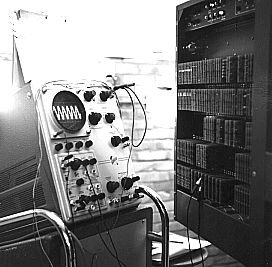
|
|
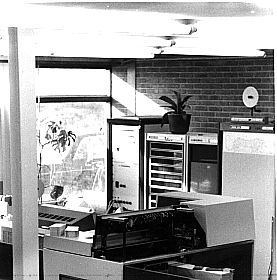
|
Maintenance at CERN.
It was at the end of the month of June 1971 that I have
arrived at the Geneva railway station Cornavin. After
having spent the night in a hotel, a Control Data manager came
to pick me up in order to go to C.E.R.N., where I had started
a job as Customer Engineer.
The initial duration off the contract was fixed for two
years, but I finished by staying in Switzerland from 1971 up to 1995,
which makes up a total of nearly twenty four years instead of the
initial two years.
My job at the C.E.R.N. site was about the same as
it was at Electrofact, with the only difference that here it
was rather preventive maintenance on all sorts of peripheral
equipment's, like the card readers, the card punches, tape drives,
printers and other maintenance tasks.
The computer center was just aside the administrative
building, but moving was planned into a brand-new building elsewhere
on the site.
|
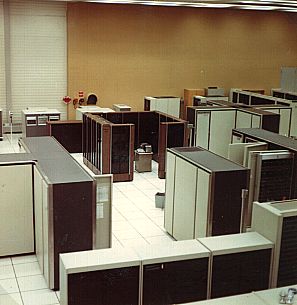
|
The photographs shown here display the C.E.R.N.
computer site of that time.
The first picture shows the section where the
mainframes themselves were installed, the second shows some of
the Control Data crew occupied with a preventive
maintenance task, and the last picture shows the section where
the tape drive units were installed.
Ok what me concerned, I as in the beginning not in
charge of the mainframes, therefore we had our specialists.
But after some time time it has become clear that this task
should be spread over several people, then as this was the use at
that time, we had a so called “on Call” service, and
thereby a morning and an evening crew. As result a
to limited mainframe specialist crew, was that those who were
specialist were called out to often.
First my colleagues and me we have learned the first
notions of fixing, identification and repairing of the problems
with the so called “Front-Ends”, the first
tasks were to identify memory problem and to replace the possibly
defective modules.
After a while, the more and more we have got
involved with more important tasks, like installing so called
“Field Change Orders”, this were corrections
done to the hardware wiring, what Control Data usually
installed afterwards. First you should take out
exiting wires. This sounds more simple as it was,
then you should imagine that the wiring map was usually a dozen
centimeters thick ore more.
Under this conditions it was not very easy to take out, p.e. a
wire from module K18 pin 22, especially when this one is below a
dozen centimeters of tight wiring, and also attention has to be
paid to that you should not take out the wire aside.
After this more or less introduction period, my
collages and me have been sent for further training in Paris
where Control Data had a training center, for training on
the “Control Data 7600”, which was the
most powerful computer at that time.
|
|
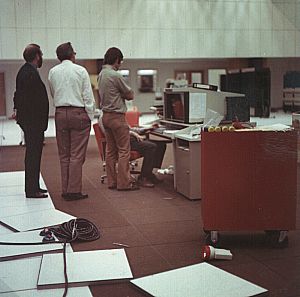
|
|
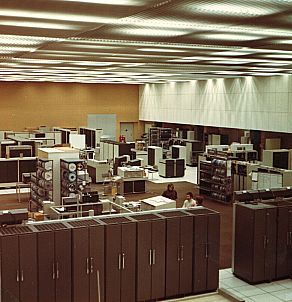
|
Systems engineer at CERN.
|
Once back from our Paris training we had to practice
what we learned over there, and now we had also some more rights,
in other words the right to called out at night like the others.
That what you are seeing on the first image aside,
is not a piece belonging to the mainframe or any other processor
or so, no it is a 600 Mo disk drive, which needed also
maintenance so one in a while. For example cleaning
the heads and disk platters, also head replacement had to be done
if they became to weak, verify the hydraulic circuit used for
head positioning, and others...
The second picture shows a session of controlling
the coherence of the machines internal signals. Then
in case of a to big shift between two signals, one should either
try to replace the module, or as alternative change the
wire-length, as anybody knows, electricity travels at light
speed, and about 30 cm of wire make up one nano (10 -9)
second. Very often a wire length change in order of
a meter cleared the problem.
The harder fixing of all of them was the Control
Data 7600 (Photo below), then this one was a RISC type
conception, and was be able to execute several instruction at the
same time, who of course is not not an advantage for problem
diagnosis.
Not
only that the 7600 could execute several instruction at
same time, most of them were treated by separate execution units.
This is maybe very good for the execution speed, but
an absolute disaster when you try fix the thing.
|
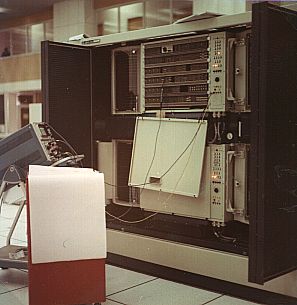
|
|
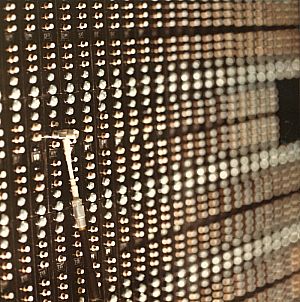
|
The Control Data 7600.
|
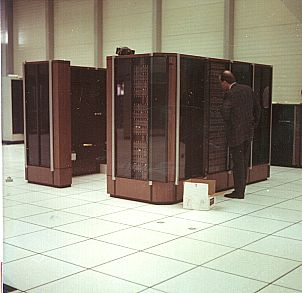
|
The Control Data 7600, shown on the picture
here is the machine on which I have spent most of my time in my
last year at the C.E.R.N. site.
In the beginning I have done the same type of work
as the others of the crew, e.g. maintenance, fixing of problems
and the “On Call” service. But
after a while it became the more and more necessary to
familiarize a person of the technical
crew with the internals of the operating system. So
it came that I have spent some time in Frankfort to learn more
about system analysis, system programming and installation.
|
The Control Data 7600 was a machine in conception
very close to what is today better known as a RISC processor (Reduced
Instruction Set
Computer). The 7600
was in fact able to start a new instruction every clock cycle (27
nano-seconds). The main processing unit was split up
into several separate units who could each operate in a individual
manner, and some even could handle several operands in a row.
The memory had an access time of less then 80 nano-seconds, e.g. the
data was available at the third clock cycle (27 nano-seconds) or in
other words between 54 and 81 nano-seconds, thereafter a wait of 270
nano-seconds the memory section was again available. The
7600 had 32 of this memory sections organized in a stripping
manner as we do find today with RAID 0 disk dives. The
memory bus itself had a transfer capacity of 270 Mo / sec.
Whereby the I/O was not done by the main processor, but
the 7600 had ten specialized processors fro that task, it was
up to them to struggle with I/O stuff.
System analyst at EPFL, Lausanne.
Little by little I have made myself more familiar with
operating systems, but also with programming, even when the
programming languages used where not at all the same as the ones
commonly used in business. Then the system itself was
entirely written in a Control Data assembly language and had
no structure in common with the languages used in business.
The second language I have learned that time, is Fortran, but
that was to make various utilities any kind, but was not at system
level.
It was somewhere in the middle of the 80's when I have
been affected to the E.P.F.L. site in Lausanne as systems
analyst, when this position became available.
My initial assignment was to backup the systems analyst
already in place and do compilations and assembly's of the customers
operating system, give follow up on software problems (or bugs if you
want) and other problems. We had also to adapt the
operating system to the customers needs with every release, verify
and add in the local modifications, as well recompile all customer
specific plug-ins. An other task was to analyze
the so called “Dump” ,that were memory listings
which occurred when a important system error occurred.
Sometime we could identify the problem, and the case of a hardware
problem caused always a problem with some of our technicians who
systematically disagreed, however in the other case I had to send the
tape the support center in the U.S.A.
As mentioned above, in the beginning I have backed up
the systems analyst already in place, who was doing also the customer
support part of the job, but when he left the company, it was up to
me to take this over with the help of the software specialist of the
Zurich office.
Towards the end of my “Lausanne” time I have
started to investigate in Micro processor techniques of that time.
There were already some of my colleagues who did have their own Micro
Computer, but what I needed most was something what could do the
communication tasks and what would allow me to download systems
corrective code and small electronic documents. The
method used by my college analyst was to list everything on a
terminal, record it onto a tape, then switch from an external
connection to the internal mainframe and play back the tape instead
of typing it on the keyboard. In order to automate this
type of operation, I had bought myself an small machine equipped with
CPM 80 and a Z80 processor. (yes in
that time we still could choose different systems as
Intel-Microsoft).
It was this little machine who was next programmed to do this kind of
tasks, it was faster, more reliable and a lot easier.
Thereafter my little machine has largely been used to do this type of
data transfer, but I used it also to edit text and programs in
“Off-Line” mode, that means that we create or
modify the texts on the local machine and as following transfer the
whole to the mainframe for processing.
But before all this I had to create the connect scripts
and the data transfer programs for this machine and other utilities.
It has been those operations who have largely
contributed to my actual knowledge of the 'C' programming luggage.
The beginning of Micro Computing.
It was after Control Data closed down his offices
in Suisse-Romande that I have become an independent technician, and
have started thereby investigate more seriously in the subject
Micro-Computing. In fact I could already quickly start
to collaborate with an technical consulting office active in the
construction domain in Wallis where I lived at that time.
I had to update and keep up to date their programs, create new ones,
or even refurbish exiting programs (rewrite them), and following that
prepare the installation procedures. Thereafter I had to
do the install at their customers. Included in this was
also the final user support. There were other obvious
things like follow up of problems. The other thing which
was coming up at that time was final customer support, repair and
general support of MS-DOS systems (some called it MESS-DOS!), what
was not a luxury those days.
After a certain time had to go on with training in order
to get further on professionally, the course chosen was a project
management training who contained all the necessary elements for
business computing and the handling of projects. After
this training I have followed a complementary
training for the Microsoft Windows environment, and the
programming of it.
It was finally during the period from end 1993 up to
beginning 1995 that I have continued my professional training in the
UNIX - ORACLE - NETWORK direction, on which I can add as of the last
years LINUX in self training.
It was during the year 1994 that I have preferred to
continue my activity in France rather as in Switzerland.
Just think, the Paris region has twice as much industries and
inhabitants as whole Switzerland add-up, and 55 times the region of
“Walis” where I used to live. And that was a
to important difference.
|









